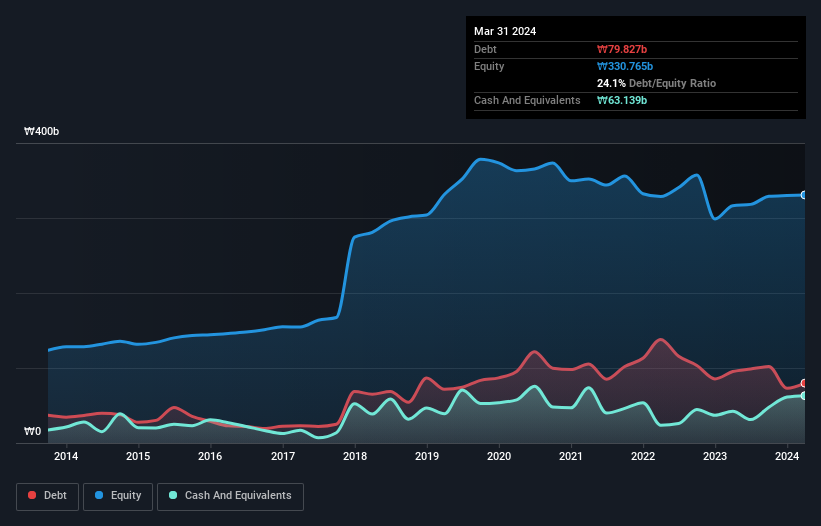- South Korea
- /
- Semiconductors
- /
- KOSDAQ:A065130
Does TOP Engineering (KOSDAQ:065130) Have A Healthy Balance Sheet?
Howard Marks put it nicely when he said that, rather than worrying about share price volatility, 'The possibility of permanent loss is the risk I worry about... and every practical investor I know worries about.' When we think about how risky a company is, we always like to look at its use of debt, since debt overload can lead to ruin. We note that TOP Engineering Co., Ltd (KOSDAQ:065130) does have debt on its balance sheet. But the real question is whether this debt is making the company risky.
What Risk Does Debt Bring?
Debt and other liabilities become risky for a business when it cannot easily fulfill those obligations, either with free cash flow or by raising capital at an attractive price. Ultimately, if the company can't fulfill its legal obligations to repay debt, shareholders could walk away with nothing. However, a more usual (but still expensive) situation is where a company must dilute shareholders at a cheap share price simply to get debt under control. Of course, debt can be an important tool in businesses, particularly capital heavy businesses. The first step when considering a company's debt levels is to consider its cash and debt together.
Check out our latest analysis for TOP Engineering
How Much Debt Does TOP Engineering Carry?
The image below, which you can click on for greater detail, shows that TOP Engineering had debt of ₩79.8b at the end of March 2024, a reduction from ₩95.3b over a year. However, it also had ₩63.1b in cash, and so its net debt is ₩16.7b.

How Healthy Is TOP Engineering's Balance Sheet?
The latest balance sheet data shows that TOP Engineering had liabilities of ₩194.5b due within a year, and liabilities of ₩9.84b falling due after that. On the other hand, it had cash of ₩63.1b and ₩148.9b worth of receivables due within a year. So it can boast ₩7.74b more liquid assets than total liabilities.
This short term liquidity is a sign that TOP Engineering could probably pay off its debt with ease, as its balance sheet is far from stretched.
We use two main ratios to inform us about debt levels relative to earnings. The first is net debt divided by earnings before interest, tax, depreciation, and amortization (EBITDA), while the second is how many times its earnings before interest and tax (EBIT) covers its interest expense (or its interest cover, for short). This way, we consider both the absolute quantum of the debt, as well as the interest rates paid on it.
TOP Engineering has a very low debt to EBITDA ratio of 0.42 so it is strange to see weak interest coverage, with last year's EBIT being only 2.0 times the interest expense. So while we're not necessarily alarmed we think that its debt is far from trivial. Notably, TOP Engineering made a loss at the EBIT level, last year, but improved that to positive EBIT of ₩7.0b in the last twelve months. There's no doubt that we learn most about debt from the balance sheet. But it is TOP Engineering's earnings that will influence how the balance sheet holds up in the future. So when considering debt, it's definitely worth looking at the earnings trend. Click here for an interactive snapshot.
Finally, a business needs free cash flow to pay off debt; accounting profits just don't cut it. So it's worth checking how much of the earnings before interest and tax (EBIT) is backed by free cash flow. Happily for any shareholders, TOP Engineering actually produced more free cash flow than EBIT over the last year. There's nothing better than incoming cash when it comes to staying in your lenders' good graces.
Our View
Happily, TOP Engineering's impressive conversion of EBIT to free cash flow implies it has the upper hand on its debt. But the stark truth is that we are concerned by its interest cover. When we consider the range of factors above, it looks like TOP Engineering is pretty sensible with its use of debt. While that brings some risk, it can also enhance returns for shareholders. The balance sheet is clearly the area to focus on when you are analysing debt. But ultimately, every company can contain risks that exist outside of the balance sheet. For example TOP Engineering has 3 warning signs (and 1 which makes us a bit uncomfortable) we think you should know about.
If, after all that, you're more interested in a fast growing company with a rock-solid balance sheet, then check out our list of net cash growth stocks without delay.
Valuation is complex, but we're here to simplify it.
Discover if TOP Engineering might be undervalued or overvalued with our detailed analysis, featuring fair value estimates, potential risks, dividends, insider trades, and its financial condition.
Access Free AnalysisHave feedback on this article? Concerned about the content? Get in touch with us directly. Alternatively, email editorial-team (at) simplywallst.com.
This article by Simply Wall St is general in nature. We provide commentary based on historical data and analyst forecasts only using an unbiased methodology and our articles are not intended to be financial advice. It does not constitute a recommendation to buy or sell any stock, and does not take account of your objectives, or your financial situation. We aim to bring you long-term focused analysis driven by fundamental data. Note that our analysis may not factor in the latest price-sensitive company announcements or qualitative material. Simply Wall St has no position in any stocks mentioned.
Have feedback on this article? Concerned about the content? Get in touch with us directly. Alternatively, email editorial-team@simplywallst.com
About KOSDAQ:A065130
TOP Engineering
Develops, manufactures, and sells LCD/OLED/LED, camera module, test, secondary battery, and roll to roll equipment in South Korea and internationally.
Adequate balance sheet and slightly overvalued.
Similar Companies
Market Insights
Community Narratives



